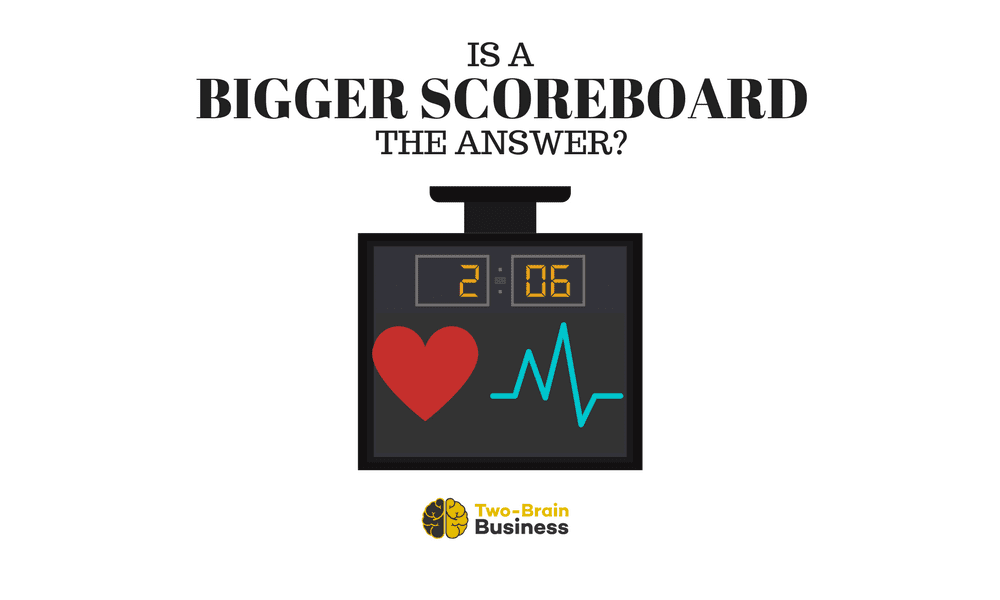Last year a local high school built a new football field.
Football isn’t our primary sport in Canada, but the local competition is fierce, and we get just as excited about it. So the new football field included a bit more seating, and a huge scoreboard. You can clearly see the scoreboard from the highway if you’re just driving by.
The team had a losing season; the larger scoreboard didn’t help. That’s obvious. But the larger scoreboard also failed to draw more fans to the game. If you’re running a volunteer football team, that probably doesn’t matter. If you’re running a for-profit gym, that matters a lot.
In 2016, I was approached by Polar to test their new score boarding software. After their break with OrangeTheory, Polar wanted to sell their technology to other gym chains, and the TwoBrain family appealed to them as a “tip-of-the-spear” group of owners. We set up their heart rate scoreboard in the gym, with predictable results: clients looked at the screen during the workouts, thought it was “cool” for awhile, and then went back to their WOD scores. I was disappointed: the tech is colorful, syncs easily and creates the opportunity to sell chest straps to clients.
Then I had a conversation with Ray from UpCoach about heart rate testing. A local gymnastics club asked him to test VO2max on their athletes. He replied, “How will the results of the test change your training program?” They didn’t have an answer. His suggestion was to avoid testing anything unless you were prepared to make changes afterward.
Before adopting a heart rate scoreboard in their gym, I think there are two bigger questions that coaches and owners need to ask:
Coaches: “Will I change our programming based on the results I collect from this new data?”
(assuming you’re collecting data and using that to determine future programming, of course.)
Owners: “Will this new tech bring in new revenue?”
That question, in turn, can be split into two more:
“Will this new scoreboard help me attract new clients?” – maybe, if it features large in your media and you tell people how it will benefit them. Orange Theory has done a good job of taking one tiny correlate of fitness and making it a lynchpin concept. You could go much further by explaining HRV and the value of your training. But most gym owners don’t publish enough content for this to have any measurable value. And there’s more to Orange Theory’s marketing than just the scoreboard; it’s a feature, but not the only benefit they sell.
“Will this new scoreboard help me increase revenue from current clients?” – yes, but only if you’re doing regular 1:1 goal reviews with your clients. Forget the couple of bucks you might make selling chest straps. If your coaches are reviewing clients’ progress with them in person, and then revising their prescription every few months, every piece of data is helpful. If you’re just selling choreographed fitness classes, the data is moot.
For example, I just had my bloodwork done, along with 10 members of my gym in a pilot project. My cortisol levels were high, so my coach told me to cut back on intensity and increase my low-intensity aerobic work. So now I do 3 days of CrossFit per week, and 3 days of easy skiing. I can feel my stress level dropping. But if the coach had another data point–like resting heart rate–to show me, I’d see immediate proof that I’m making progress. THIS is where more data is helpful: in creating peak moments and proof for clients.
The novelty factor of a new, colorful scoreboard can’t be ignored. It might attract clients that will stay until the novelty wears off. Those clients aren’t my ideal market.
But the ten-year client IS my ideal market, and more data points to show progress is important in my retention strategy. The key is having 1:1 conversations with the coach, and updating their prescription accordingly. If you have goal review sessions, heart rate scoreboards can be a beautiful thing (and so could the Level Method or a plain old whiteboard). If you don’t, the benefit is probably the same as having high-end weightlifting equipment: just another expense that won’t drive new revenue.
Wodify’s new heart rate monitoring system COULD be a breakthrough for your business…or it could just be another big scoreboard. Are you set up to capitalize on it?

